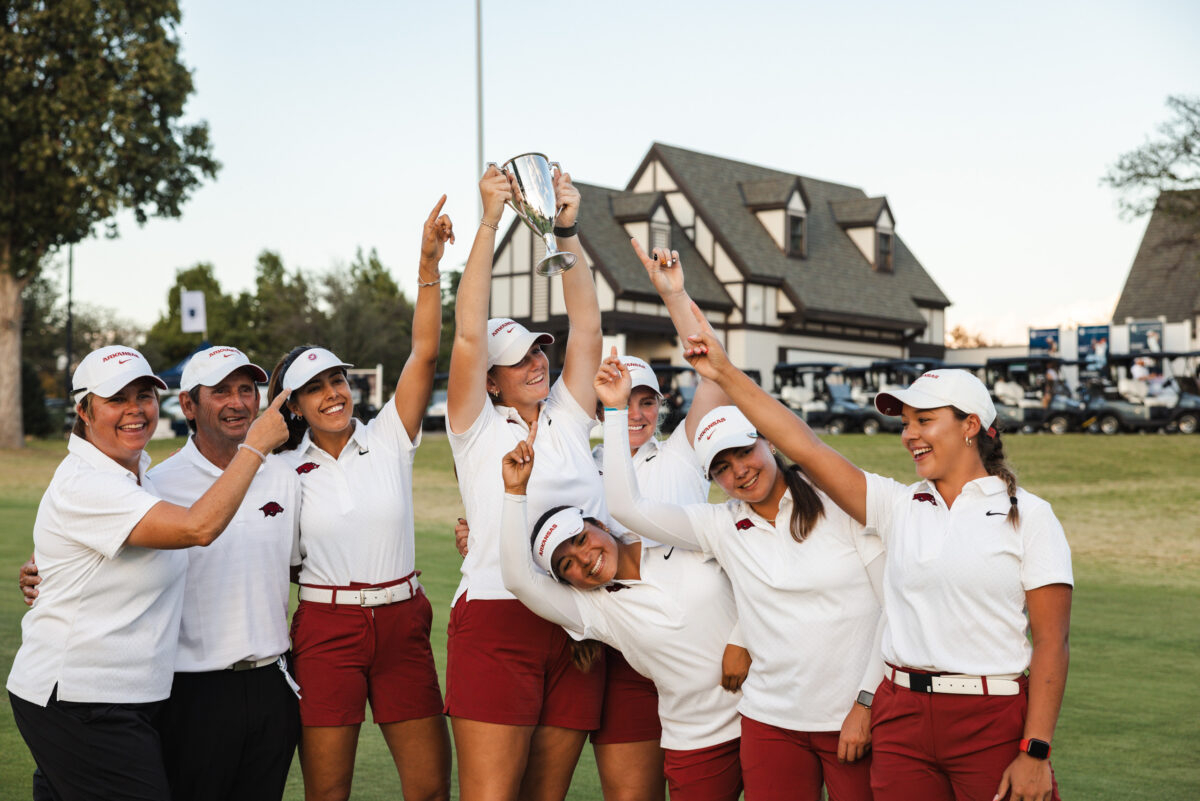NICHOLS HILLS, Okla. — The constant movement of golf carts between shots. The humming sound of generators strategically placed at different spots on the course. Camera crews running on the fairways between players preparing to hit their shots.
Those are all common sights and sounds at professional golf events, but in the last decade they’ve become more commonplace in college golf, especially the Division I level.
The D-I college golf national championships were broadcast on Golf Channel for the first time in 2014, with the men having a year in the spotlight before the women got their camera time a year later. Ever since, the sport’s footprint has grown and continued to do so. This fall, more than 180 hours of college golf is being shown on Golf Channel, including live events five straight weeks in October.
“It certainly changed for the good, all positive,” Oklahoma men’s coach Ryan Hybl said. “I mean, we have way more folks that are willing to come out and watch us. I think it’s only a positive. I certainly think that the pressure has been escalated, which is not a bad thing.”

For certain programs, like Oklahoma, playing on TV has become commonplace. The national championship is a place teams look forward to the air time, but at many top tournaments in the fall and spring, cameras are darting around following the future stars of the professional games and giving players their first glimpse at what it’s like to play with a bit of added pressure.
Last week, the Jackson T. Stephens Cup featured, at the time, the top-ranked men’s and women’s programs in the country competing at Oklahoma City Golf and Country Club: the Oklahoma men and Arkansas women. Just this fall, it was the Razorbacks second time being on camera, in addition to their home event, the Blessings Collegiate, earlier this month.
“It gives great exposure to our golf program,” Arkansas women’s coach Shauna Taylor said. “It really gets us, you know, for us, specifically, at blessings collegiate we can showcase our home, and that’s that’s so valuable for us for three days to show Blessings.”
Maria Jose Marin, a standout sophomore for Arkansas, has gotten used to cameras following her in recent months. She captured medalist honors at the U.S. Women’s Amateur at Southern Hills in Tulsa, Oklahoma, in August, before making a run into the semifinals. The next month, she competed at the LPGA’s Walmart NW Arkansas Championship, made the cut, and after completing her final round was playing at the Blessings Collegiate the next day.
Fast forward to last week, she led the Razorbacks to a team title at the Jackson T. Stephens Cup, their third win of the fall. Two of those came on TV.
“That’s huge for her and huge for our program and our brand and their exposure and our exposure,” Taylor said. “It’s priceless.”

The growth of college golf on TV has also been boosted by top amateur events also getting their share of air time. The Augusta National Women’s Amateur has provided an avenue unlike any other for the top female amateurs to have their stories told and build their brands. The USGA has done a good job of showcasing its junior and amateur events to audiences, and players continue to make their names winning some of the country’s most prestigious events.
But now, unlike in the past, the top amateurs don’t go into the shadows during the fall and spring when they’re in college. They remain on TV, representing their colleges.
“People really tune in. People really look forward to it,” Stanford coach Anne Walker said. “I don’t ever remember people being able to really follow the individuals within the sport. You could follow a team, but it was harder to really track on the individuals and the individual stories and what their journey had been. These stories just keep pouring into people’s homes, so you can really follow your favorite players now.”
Walker coached the greatest female amateur of all-time, Rose Zhang, whose fame and popularity was without a doubt bolstered by her success playing on television, whether it was her pair of individual wins at the national championship, the Augusta National Women’s Amateur victory, a pair of trophies in USGA events and more.

College golf also fits into an early-week time slot when the professional game isn’t playing, giving those looking for live action an avenue to watch the top amateurs in the world. For those players who capitalize on that opportunity, the sky’s the limit for how it can propel them into the future.
Walker used the example of the Caitlin Clark effect in the WNBA this year, resulting in record crowds and viewership numbers. Even Walker said she was drawn to the sport after not paying much attention to it in the past.
Yet TV gave the sport and Clark a platform to grow, and it skyrocketed. College golf has done the same, and there’s still room to grow.
“We need to have really compelling individual stories to draw people into golf, and then once we get them in, then they will be compelled to follow teams, and then they’ll be compelled to follow college golf and LPGA golf,” Walker said.
